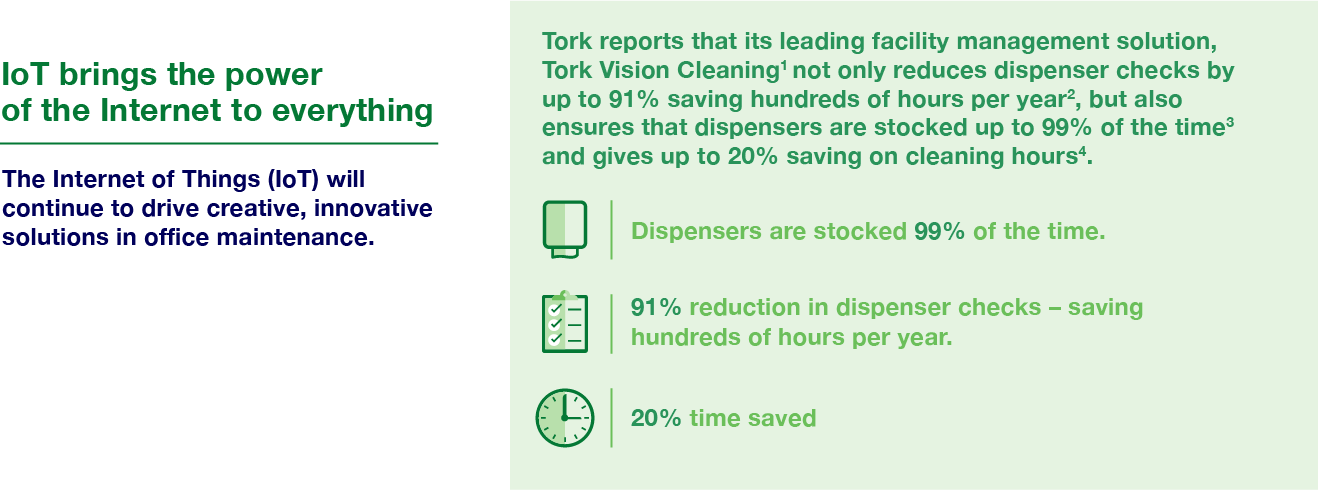Ask the average person what “office maintenance” means today and they’ll probably say something to the effect of “cleaning crews emptying waste cans and pushing vacuums.” But ask the same thing of a professional facilities manager and they’re more likely to talk excitedly about how high tech is lowering costs and raising tenant satisfaction. Here are just a few of the trends that have facilities managers excited.
Dashboards replace dashing around
Whether handling a single office or multiple locations, facilities managers and their office maintenance teams often have to dash from one need or problem to the next, and from one floor or facility to the next. The growth in use of dashboards – another name for comprehensive software control panels used on desktop computers or mobile tablets – is helping reduce legwork considerably.

For instance, the maintenance module of an integrated facilities management dashboard can give managers the power to remotely:
- Keep track of work orders from anywhere, throughout the process from order submission to completion
- Schedule maintenance or rapidly react to requests
- Communicate with workers remotely
- Monitor supply levels
- Track worker performance
Task-specific dashboards, such as software-enabled systems for smart bathrooms, allow managers to remotely monitor visitor numbers and refill levels in real time, and track performance against custom-specified KPIs.
So how much of a difference do these systems really make?
IoT brings the power of the Internet to everything
The Internet of Things (IoT), and its ability to connect virtually anything anywhere, underlies all of those dashboards, enabling data-driven cleaning and much more. Remote sensors provide real-time monitoring of multiple factors, from supply levels to dust levels and overall air quality, helping ensure greater tenant satisfaction. Given the tremendous growth in connected devices – from 8.3 billion in 2017 to 20.4 billion projected for 2020 – IoT will continue to drive creative, innovative solutions in office maintenance.
Tork reports that its leading facility management solution, Tork Vision Cleaning1 not only reduces dispenser checks by up to 91% saving hundreds of hours per year2, but also ensures that dispensers are stocked up to 99% of the time3 and gives up to 20% saving on cleaning hours4.

Robots are cleaning up, in every sense
Cleaning robots are definitely on the rise, with the professional services robotic market expected to be worth $37 billion by 2021. No longer just the whirling automatons that vacuum up pet hair or the popcorn in your TV room at home, robots are now busy in the workplace, cleaning floors, windows, outdoor spaces, and even pools and fountains. Best of all, every time a robot cleans up, labor costs go down.
Office maintenance is getting smart from the start
The smarter office buildings get, the easier office maintenance will be. While the bulk of innovation has been applied to retrofitting existing office with technology, ground-up designs for new structures will enable more innovation and efficiency. More built-in sensors – like the 15,000 sensors embedded in the newly built Unilever corporate headquarters – will provide more detailed, up-to-the-second information on what needs to be cleaned, where, and when, further optimizing use of staff. And new technologies, like light-fidelity (LiFi) networks, will provide the boost in bandwidth that new innovations demand (LiFi doesn’t have the bandwidth limitation of radio-spectrum WiFi, as it uses LED lighting to transmit and receive data in a secure environment).
New tech requires new training
All of these new capabilities require a higher level of knowledge for maintenance workers – and that means a new commitment to training. In addition to initial learning on new apps and the connected devices that use them, continuous training should be factored in, ideally with specific needs per individual worker identified via IoT-enabled performance tracking.
All of this may seem all too complicated, but technology can help here, too. As AI (artificial intelligence) and machine learning become more sophisticated and widely deployed, the connected systems and devices will, in essence, be able to continually learn about their operators and personalize their operation according to the weaknesses and strengths of each worker.
More efficiency to come
Office maintenance will always be hard work – but smart buildings (and smart facilities managers) will make it look easier and more efficient than ever.
Sources
1 Tork Vision Cleaning was formerly known as Tork EasyCube®
2 Measured across nearly 13,000 connected dispensers between June-December 2019, based on time per month that a dispenser is in an empty status against total time per month.
3 Based on customer feedback for dispenser checks over 6 months before vs after installing Tork Vision Cleaning (between June-December 2019). Measured across 16 sites connected to Tork Vision Cleaning, with each dispenser check taking approx. 20 seconds.
4 Measurement of visitor satisfaction in two Tork Vision Cleaning washrooms and two traditionally maintained and equipped washrooms at ISSA/Interclean exhibition, May 2016.
MarketWatch: Robot Cleaner Market Demand
CBRE: Top Trends in Facilities Management
iOffice: Facilities Management Dashboards
Building Design + Construction: Smart buildings take hold
